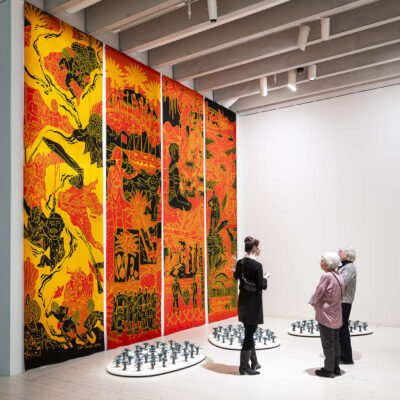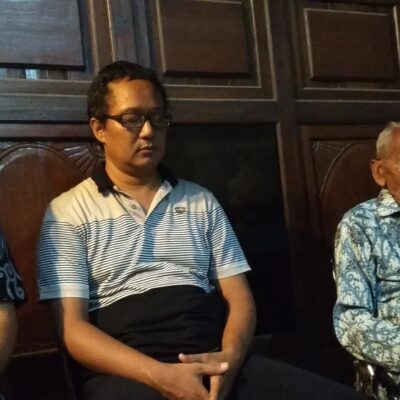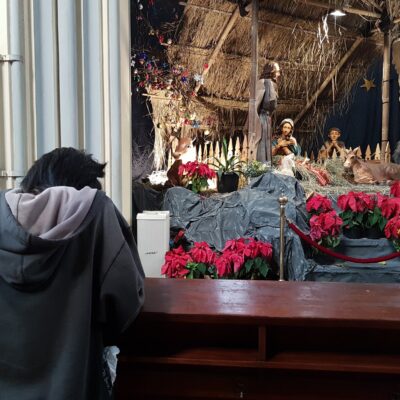‘Di Pulau Buru, laut seperti seorang ibu,’ begins Laksmi Pamuntjak’s novel Amba (2012): ‘On Buru Island, the sea is like a mother.’
The line unsettles. Pulau Buru is the site of the most infamous forced-labour camp of the New Order, the military regime that ruled Indonesia from 1966–1998. More than 10,000 activists, teachers, artists, and journalists were imprisoned on Buru; now the setting of several memoirs and a documentary on the violent repression of Indonesia’s left.
Pamuntjak introduces Buru as a natural environment. Nature outlasts history: though human horrors took place here, the mother-sea is ‘dalam dan menunggu,’ ‘deep and abiding’ (in Pamuntjak’s own English translation, ‘It knows how to wait’).
Though the novel’s reckonings with Indonesian history are already much-discussed, its environmental vision has attracted less attention. The two are intertwined: Amba presents political events as unfolding within the more enduring cycles of nature, and of myth.
Myth and history
Amba is set mainly between 1956 and 1966, years in which Indonesia’s young parliamentary democracy gave way to the ‘guided’ variant of independence leader and first President Sukarno. Democracy was guided straight into a military coup, followed by the mass murder of around a million leftists.
The eponymous protagonist is a central Javan village girl who finds independence at university in the coastal metropolis of Yogyakarta in the early 1960s. She wavers between two lovers: Salwa, the favourite of her parents, is an apolitical Javanese Muslim who values respectability and tradition. Bhisma is an aristocratic, European-educated surgeon, involved in the Communist movement. Bhisma disappears in the violence of October 1965, and sections of the novel are set in post-Reformasi 2006, as Amba tracks him to the labour camp on Buru. So far, we are in familiar territory for the historical novel: our characters represent social forces greater than their lives as individuals; their love triangle dramatises the political transformation of a nation.
Yet Amba also retells a myth. Its principal characters are drawn from an ancient, encyclopaedic Sanskrit poem: the Mahābhārata. Composed between the middle of the first millennia b.c.e. and c.e., this greatest of Indian epics recounts a war between two branches of a ruling dynasty. Pamuntjak recasts one episode of this war: Ambā, a princess betrothed to King Śālva, is abducted by the warrior Bhīṣma. When Śālva will not take her back, she dedicates herself to revenge. Reborn as the sex-changing warrior Śikhaṇḍī/Śikhaṇḍin, she finally kills the invincible Bhīṣma, breaking the stalemate and allowing the war to end (5.170–193, 6.103–115).
Thus Amba, Salva, and Bhisma belong not to history, but to myth: Indonesia’s massacres are one more historical circumstance through which their tale abides.
Telling and retelling
Pamuntjak is interested in what happens to stories as they travel from one culture to another. Born in Jakarta and educated in Perth, Australia, she writes in Indonesian and English. She also translates her own work. The Indonesian Amba was published in 2012, with an English version, retitled The Question of Red, following in 2014. (For the 2019 sequel Fall Baby, Pamuntjak composed in English and translated into Indonesian.)
Amba, too, is a translator, and through her Pamuntjak lays out a metaliterary programme: ‘When she translated a line, never mind an entire work, she became aware that the original ceased to be, as she had led it to a place where it could not survive in its pure form.’ Pamuntjak’s auto-translation plays with this idea, omitting whole paragraphs of Indonesian and inventing new sentences in the English. In the Indonesian version of this passage, Amba ‘discovers how vast is the human voice’ (ia menemukan suara manusia yang begitu luas, 154). In the English, she winkingly quotes her own original: ‘A famous translator once said prosody embodies the vastness of the human voice’ (112, emphasis mine). The novel insists ‘telling is always retelling, casting the old anew’ (63; ‘mengisahkan selalu berarti mengisahkan sebuah cerita lama yang jadi baru,’ 108).
Naturally, Pamuntjak is interested in previous Indonesian retellings of Sanskrit epic. The spread of Sanskritic culture through the Malay Archipelago not only reshaped its languages, but gave it its literatures. The earliest Indonesian texts based on the Mahābhārata are the Old Javanese Parwas, which begin to appear in the tenth century. Like Amba they are not translations but retellings: they condense, select, localise their source. One Parwa announces its intent to ‘mangjawāken Byāsamata,’ Javify the mind of Vyāsa (legendary composer of the Mahābhārata). These adaptations live on today in the puppet opera of Java and Bali: the wayang, whose oldest and most popular narratives draw from the (Javified) epics.
Wayang—centuries old, composed in an archaic language, and deeply associated with the political heartland of Java—is even more than its Sanskrit inspiration the classical foil for modern Indonesian literature. Any reference to Sanskrit epic necessarily passes through wayang. Pamuntjak uses this double allusion to develop her environmental and political themes through two points of reference: the Mahābhārata, and her many predecessors in the Malay Archipelago.
The politics of nature on Buru
The world of the Mahābhārata is continental. In a lengthy geographic survey, the poem lays out its own limits as the Indian Ocean in the west, the Bay of Bengal in the east, and the impenetrable Himalayas in the north. Southeast Asia, across the ocean, is inhabited by casteless peoples: a non-place where karmically significant action is impossible. The realm that matters is ‘bounded by sea’ (sāgarāpāṅga, 6.5–13).
In the 10,000 islands of Indonesia, the ocean is not the end of the world, but the condition of its connectivity: on Buru, the sea is like a mother. Thus Pamuntjak, like her medieval precursors (the geographical survey was first adapted in the Old Javanese Bhismaparwa), must reshape Sanskrit epic to an oceanic ecosystem, asserting the moral and political significance of the Malay Archipelago and the people in it.
She presents this struggle through Bhisma’s changing relationship to his life on Buru. He first sees the island as ‘nature’s prison’: in a parody of the Mahābhārata’s geography, he explains he is walled in on all sides, by thick-forested mountains and the sea. Bhisma is trapped in the Mahābhārata’s vision of nature, badly translated to the Archipelago: his world is ‘ocean-bounded’ (dikepung laut, 59).
He is trapped too in its political economy. The Mahābhārata states explicitly that the war is fought in part for resources: whoever wins will own the riches of the earth (6.5, 6.10). But the Indonesian Bhisma faces this prospect not as a prince of the metropole, but as an unpaid worker in the imperial periphery. He tells ‘how the political prisoners were utilized to transform this island, their forced labor turning virgin land into rice fields, planting vegetables to eat and sell, building roads’ (32).
Bhisma speaks in this scene, not accidentally, to Manalisa, leader of the indigenous communities on Buru. Later in the novel, we get his reply: ‘[Manalisa] told me that male energy flows like nature’s energy and will never cease as long as nature remains. He has taught me how to be at one with this energy—walking the entire span of the island, learning to communicate with the waves, living at peace with the cold’ (391). Bhisma comes to see himself as part of his environment, a flow of energy within another much larger.
Though Manalisa is indigenous to the Maluku islands, his philosophy builds on classical Javanese foundations. Benedict Anderson, the most influential Western analyst of Indonesian culture, has observed how Javanese literature (including wayang) identifies political power with masculine sexual potency and supernatural control of the environment. Speaking in 1967, the diplomat Soedjatmoko saw belief in a ‘direct relationship between the state of a person’s inner self and his capacity to control his environment’ as key to Indonesian concepts of power. A leader ‘rules by divine sanction’ and his ‘state of inner development is reflected in the condition of his realm.’ Male energy flows like nature’s energy: Bhisma learns to communicate with the island, rather than transforming it to extract its resources. An Indonesian theory of power answers the dismissal of the Mahābhārata.
By allying with the island against their shared exploiter, Bhisma converts the prison camp to a kind of primitive communism: ‘Here, even if life boils down to one thing—unpaid labor—at least we still see the sky, feel the breeze, breathe the air, hunt, enjoy the taste of sago and local fruits, and catch fish in the lake’ (371). Hunting in the morning, fishing in the afternoon—‘Bung Pram’ even makes a cameo to criticise after dinner. (Bung Pram is the nickname of Pramoedya Ananta Toer, the greatest Indonesian novelist, was incarcerated on Buru and composed his most famous work there.) Even in such appalling conditions, worthwhile human life is possible, for human happiness is simple: we need music, food, air and water, sunlight, and maybe some paper to write on.
Thus, Pamuntjak’s technique of double allusion serves an environmental vision of simple but fulfilling human life within a sustainable economy. From indigenous and Javanese ways of living in nature, Pamuntjak develops a compelling alternative to the extractivism of the Sanskrit source. But can Pamuntjak’s technique of telling-as-retelling explain what bars us from this earthly paradise?
The red and the green
For a novel so interested in political events, Amba is suspicious of political ideas. Amba’s intellectual awakening comes not through politics but through the arts: ‘No theory. No science. No platitudes. Just folktales, and tales from the wayang, drawn from the great Indian epics, which flowed through their lives and the lives of the people around them’ (63). Theory is platitude, and the alternative is poetry: Bhisma’s comrades mock him because he writes non-political poems; later, he laughs that nobody imprisoned on Buru has actually read Marx.
Political conviction is presented as insensible to the complexities of life. Left-curious Amba takes delight in colour, especially the subtle variations of blue and green she encounters in the ocean or jungle. Bhisma, a committed activist, is by contrast red-green colourblind. Red here stands for communism, and for the bloody violence of the 1960s; green (among other things) for the environment and the simple life Bhisma will learn to value during his imprisonment. In October 1965, Amba loses Bhisma when the military attacks a meeting of student communists. The lovers are separated because, in the chaos, Bhisma mistakes the colour of Amba’s shirt and runs after the wrong woman.
At this point—the beginning of the massacres—the novel makes one of its most revealing allusions to the Mahābhārata: ‘[Amba] heard a gathering noise. A storm, she realised belatedly, bearing down upon the city … As if the heavens had decided to get in on the act and make people superfluous’ (168). The action of the Mahābhārata begins when the earth complains to the gods: there are too many humans living on her surface, and their weight is pushing her into the sea. The gods decree a great age-ending war of brother against brother, to relieve the earth by slaughtering humans in their tens of millions (1.58.1–52, 12.202.10, etc.).
To associate the violence of the later 1960s with the ‘Bratayuda’ of the wayang is nothing new. Pamuntjak’s innovation is to exploit the double allusivity: here, she looks back to the original Sanskrit epic, where the massacre is a divine conspiracy to ‘make people superfluous.’ Thus the story of Amba, Salwa and Bhisma, at the very moment it crashes into history, is taken up into a ‘celestial narrative’ (250), just as the political acts of human beings are assimilated to a (super)natural storm. This too is Javification: Anderson notes that if political potency grants control over nature, political instability manifests equally as ‘disorder in the natural world—floods, eruptions, and plagues—and … inappropriate modes of social behavior—theft, greed, and murder’ (33).
One danger of this mythicising is that divine caprice does not admit of analysis in the same way as a deliberate extermination campaign by a right-wing junta. In an unsent letter to Amba from Buru, Bhisma observes that the prisoners and their guards are not so different, sharing music and food on a festival night: ‘You of all people would understand this, you who shun the black-and-whitenesses of life’ (377). Here again, art reveals the subtleties of human communal life, better than the political ideology which divides it.
But how much colour vision does one need to see that all people like to sing and feast? The puzzle is why fellow-feeling did not prevent Indonesia’s right from murdering so many communists and alleged communists; why some people were, really and historically, guards on Buru and others prisoners; and why, through a ‘reformation’ and many changes of government, the murderers have remained secure, wealthy, and powerful.
In the years following Amba’s publication, it has been conclusively proven that the massacres were no madness of the Indonesian crowd, but a military coup abetted by Western imperial powers unhappy with Sukarno’s economic protectionism. Like the princes of the Mahābhārata salivating over the riches of the earth, the USA, UK, and Australia backed the murderers to secure gas, rubber, palm oil and tin.
The slaughter of the Indonesian left ended and upended the lives of millions of individuals who loved, wrote poetry, sang and ate together, but the victims were not targeted as lovers and poets. They were killed as bearers of an economic and political programme that stood in the way of the profitable exploitation of Indonesia’s environment and people. Here, the platitudes of theory serve better than the celestial narrative of myth: they explain why nature does not simply abide through the political events that play out within it. Bhisma’s view of red and green has much to recommend it.
Image: Traditional Wayang Performance in Central Java. Photo by Kal 347/Pexels.




